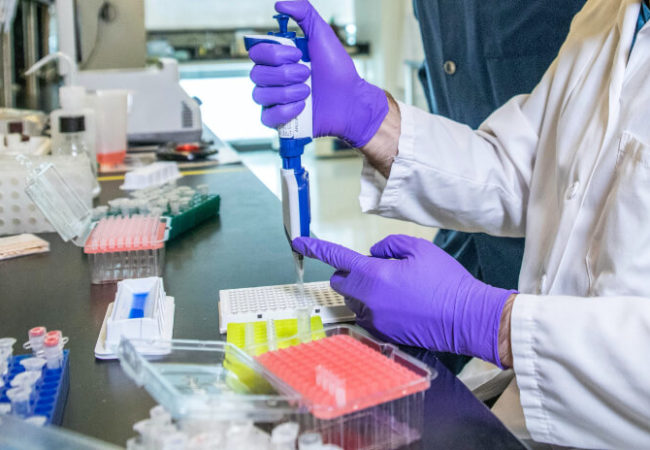Metabolite Identification

Metabolite Identification Assays
Pharmaron offers both screening and comprehensive metabolite profiling services for both in-vitro and in-vivo samples. Understanding the metabolite profile of a drug, which can differ across species, impacts several steps of the drug development process. These include choosing suitable animal models for toxicological evaluations, identifying potentially reactive metabolites, and predicting the likelihood of drug-drug interactions.
For additional service requests or customization, please contact us.
Available Express Metabolite Identification Assays:
Metabolic Stability – Expected Phase I and Phase II and Soft and Hard Reactive Metabolites
This assay is used to determine the metabolic stability of a test compound incubated with human, rat, dog, primate or mouse liver microsomes and to detect expected Phase I, Phase II, and trapped reactive metabolites.
Required from Customer
- Test article: 20 mg of powder
- Molecular mass (exact mass) of test compound and its salt form
- MSDS or handling and storage information, e.g., light sensitive, store at -20°C, etc.
Deliverables
- Stability:
- Table of % remaining of test compound at each time point
- Calculated t1/2 of test compound and control
- Calculated in vitro intrinsic clearance of test compound
- Detection of expected Phase I metabolites:
- Retention time, peak area and number of isobars detected for up to three major expected biotransformations per species
- Detection of expected Phase II metabolites (glucuronidation)
- Results of positive control (Nefazodone)
- Indication if glucuronide conjugates were detected, including retention time and signal intensity of the conjugates
- Detection of reactive metabolites
- Results of positive control (Nefazodone)
- If conjugates of reactive metabolites of test article were detected following tabulated results will be provided:
- Accurate mass measurements of molecular ions of detected conjugates of reactive metabolites, retention times and signal(s) intensity.
- Extracted Ion Chromatograms and Survey High Resolution Accurate Mass Spectra (HRAMS) of the detected conjugates in representative samples.
Substrate
- Test compound at 1 µM dissolved in liver microsomal reaction mixture
Assay System
- Human liver microsomes: 0.5 mg/mL (mixed gender, ≥ 10 donors)
- Mouse, rat, dog, or monkey liver microsomes: 0.5 mg/mL (male, ≥ 3 donors)
- Reaction mixture:
- Potassium phosphate buffer, pH 7.4: 100 mM
- Magnesium Chloride: 5 mM
- Cofactors:
- Phase I Metabolism: NADPH 1mM
- Phase II Metabolism: UDPGA 1mM
- Reactive Metabolites: GSH 5 mM containing stable labeled GSH (SIL-GSH)
- Reactive Metabolites: KCN 1 mM containing stable labeled KCN (1:1 KCN:SIL-KCN)
- Positive controls:
- Phase I Metabolism: Testosterone
- Phase II Metabolism: Nefazodone
- Reactive Metabolites: Nefazodone
Assay Conditions
- The assay is run with a single incubation (N=1)
- Stability, Phase I/Phase II Metabolism, and Reactive Metabolites
- Incubate test compound (1 µM) at 37°C in buffer containing 0.5 mg/mL microsomal protein
- Incubate solvent control in parallel, sampling at 60 minutes
- Initiate the reaction by adding cofactors (NADPH, UDPGA, GSH, and KCN), sampling at 0, 10, 20, 30, and 60 minutes
- Incubate positive control (5 µM testosterone) in parallel, sampling at 0, 10, 20, 30, and 60 minutes
- Incubate positive control (50 µM Nefazodone) in parallel, sampling at 60 minutes
Assay QC
- The control compounds, testosterone and nefazodone, are run in parallel assays to verify the activity of the CYPs
- After the final time point, fluorimetry is used to confirm the addition of cofactors to the reaction mixture
- T1/2 of controls must meet internal acceptance criteria
Notes
- The results from this assay are sent to the customer in the ExpressPlus report format, which may include graphical representations of data and comparison with historical data for reference compounds.
- This assay does not provide stability information of test compound in liver microsomes without cofactors.
- Percent remaining at each time point is calculated from the peak area response ratio of test compound (or control) divided by the peak area response ratio of the 0-minute sample.
- In vitro intrinsic clearance (CLint in-vitro) = k/P (mL/min·mg protein), where k is the elimination rate constant (min-1) and P is the protein concentration (mg/mL).
Stability with Metabolite Detection – Phase I Metabolites and Glucuronidation Liver Microsomes
This assay is used to determine the metabolic stability of a test compound incubated with human, rat, dog, primate or mouse liver microsomes and to detect expected Phase I and Phase II metabolites.
Required from Sponsor
- Test article: 20 mg of powder
- Molecular mass (exact mass) of test compound and its salt form
- MSDS or handling and storage information, e.g., light sensitive, store at -20°C, etc.
Deliverables
- Stability:
- Table of % remaining of test compound at each time point
- Calculated t1/2 of test compound and control
- Calculated in vitro intrinsic clearance of test compound
- Detection of expected Phase I metabolites:
- Retention time, peak area and number of isobars detected for up to three major expected biotransformations per species
- Detection of expected Phase II metabolites (glucuronidation)
- Results of positive control (7-HC)
- Indication if glucuronide conjugates were detected, including retention time and signal intensity of the conjugates
Substrate
- Test compound at 1 µM in liver microsomal reaction mixture
Assay System
- Human liver microsomes: 0.5 mg/mL (mixed gender, ≥ 10 donors)
- Mouse, rat, dog, or monkey liver microsomes: 0.5 mg/mL (male, ≥ 3 donors)
- Reaction mixture:
- Potassium phosphate buffer, pH 7.4: 100 mM
- Magnesium Chloride: 5 mM
- Cofactors:
- Phase I Metabolism: NADPH 1mM
- Phase II Metabolism: UDPGA 1mM
- Positive controls:
- Phase I Metabolism: Testosterone
- Phase II Metabolism: 7-HC
Assay Conditions
- The assay is run with a single incubation (N=1)
- Stability and Phase I/Phase II Metabolism
- Incubate test compound (1 µM) at 37°C in buffer containing 0.5 mg/mL microsomal protein
- Incubate solvent control in parallel, sampling at 60 minutes
- Initiate the reaction by adding cofactors (NADPH & UDPGA), sampling at 0, 10, 20, 30, and 60 minutes
- Incubate positive control (5 µM testosterone) in parallel, sampling at 0, 10, 20, 30, and 60 minutes
- Incubate positive control (100 µM 7-HC) in parallel, sampling at 60 minutes
Assay QC
- The control compounds, testosterone and 7-HC, are run in parallel assays to verify the activity of the CYPs
- After the final time point, fluorimetry is used to confirm the addition of cofactors to the reaction mixture
- T1/2 of controls must meet internal acceptance criteria
Notes
- The results from this assay are sent to the customer in the ExpressPlus report format, which may include graphical representations of data and comparison with historical data for reference compounds.
- This assay does not provide stability information of test compound in liver microsomes without cofactors.
- Percent remaining at each time point is calculated from the peak area response ratio of test compound (or control) divided by the peak area response ratio of the 0-minute sample.
- In vitro intrinsic clearance (CLint in-vitro) = k/P (mL/min·mg protein), where k is the elimination rate constant (min-1) and P is the protein concentration (mg/mL).
Detection of Glucuronides – Human Liver Microsomes
This assay is used to detect glucuronidation of a test compound after incubation with human liver microsomes in the presence of UDPGA
Required from Customer
- Either a minimum of 1.2 mL of test compound at 10 mM in DMSO, or 20 mg of powder
- Exact molecular mass of test compound and its salt form
- MSDS or handling and storage information (e.g., light sensitive, store at -20°C, etc.)
Deliverables
- Presence or absence of glucuronide conjugates formed from test and control compounds
Substrate
- Test compound at a single concentration, typically 50 µM, dissolved in aqueous buffer, acetonitrile (≤1% final), methanol (≤1% final), or DMSO (≤0.1% final)
Assay System
- Pooled, mixed-gender, human liver microsomes from ≥10 donors, with NADPH, UDPGA and alamethicin added
- LC-MS/MS is used to detect, but not quantify, peaks present in incubation with test or control compound but not in blank, and corresponding to glucuronide conjugates based on mass differential vs. parent compound
Assay Conditions
- Run the assay with a single incubation (N=1)
- Incubate test compound at 37°C in buffer containing
- 0.5 mg/mL microsomal protein, sampling at 0 and 60 minutes
- Incubate reaction mixture without test compound (blank) at 37°C, sampling at 60 minutes
- Incubate positive control (7-hydroxycoumarin) in parallel, sampling at 60 minutes
Assay QC
- The control compound, 7-hydroxycoumarin, is run in parallel to verify the enzymatic activity of the microsomes
Notes
- The results from this assay are provided to the customer in the ExpressPlus report format, which may include graphical representations of data and comparison with historical data for reference compounds.
Express Plus Glutathione Trapping in Human Liver Microsomes
This assay is used to detect a glutathione conjugate of a test compound due to formation of a reactive metabolite, after incubation with human liver microsomes in the presence of NADPH and GSH.
Required from Sponsor
- Required from Customer
- Exact molecular mass of test compound and its salt form
MSDS or handling and storage information (e.g., light sensitive,
store at –20 oC, etc.) - 20 mg of powder
Deliverables
- Presence or absence of glutathione conjugates formed from test and control compounds
Substrate.
- Test compound at a single concentration, typically 50 μM, dissolved in aqueous buffer, acetonitrile (≤1% final), methanol (≤1% final), or DMSO (≤0.1% final)
Assay System
- Pooled, mixed-gender, human liver microsomes from ≥10 donors, combined with NADPH and GSH containing stable labeled GSH
Assay Conditions
- Run the assay with a single incubation (N=1) per treatment
- Incubate test compound at 37 oC in buffer containing 1 mg/mL microsomal protein, sampling at 0 and 60 minutes
- Incubate reaction mixture without test compound (blank) at 37°C, sampling at 60 minutes
- Incubate positive control (troglitazone) in parallel, sampling at 60 minutes
- Sample analysis by LC-HRAMS-MSn
Assay QC
- The control compound, troglitazone, is run in parallel to verify the enzymatic activity of the microsomes
Notes
- The results from this assay are provided to the customer in the Express Plus report format, which may include graphical representations of data and comparison with historical data for reference compounds.
Other Express Services
Project Deliverables:
- Assay results shared in 5-10 business days
- Report shared through the secure portal
- Data archived in 21 CFR Part 11 compliant portal for posterity
- Easy check out and payment with credit card (Visa, Mastercard, AmEx) or Purchase Order
- Spend more than $25,000 within a calendar year to unlock an additional 10% discount, valid for online purchases only
Place an Online order
To view pricing and place online orders, you must have an account and be logged in.
